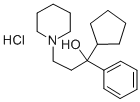Originator
Pagitane,Lilly,US,1953
Uses
Cycrimine Hydrochloride is a cholinolytic anti-Parkinson drug which can cause neuromuscular blockades in isolated rat diaphragms.
Definition
ChEBI: The hydrochloride salt of cycrimine. A central anticholinergic, it is used as its hydrochloride salt in the management and treatment of Parkinson's disease.
Manufacturing Process
The manufacture of the cyclohexyl analog is as follows. Phenyl magnesium
bromide was prepared from 48.5 g (0.308 mol) of bromobenzene, 7 g (0.29
mol) of magnesium, and 125 ml of dry ether. To it was added at 5°C over a
period of ? hour 40 g (0.18 mol) of cyclohexyl β-(N-piperidyl)-ethyl ketone
(BP 115° to 117°C/1 mm) in 125 ml of dry ether. The mixture was allowed
slowly to come to room temperature, refluxed for one hour, and then poured
into ice containing 80 ml of concentrated hydrochloric acid. Ammonium chloride (100 g) and 200 ml of concentrated ammonium hydroxide were
added and the organic layer was separated. After drying and removing the
solvent, the residue was distilled under reduced pressure. The base distilled at
158° to 170°C (1 mm) and solidified. Upon recrystallization from methanol it
melted at 112° to 113°C.
brand name
Pagitane
(Lilly).
Therapeutic Function
Muscle relaxant, Antiparkinsonian
